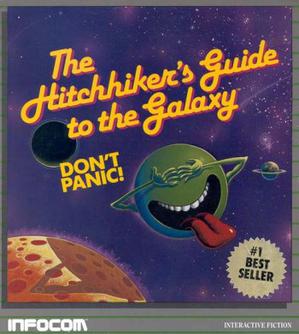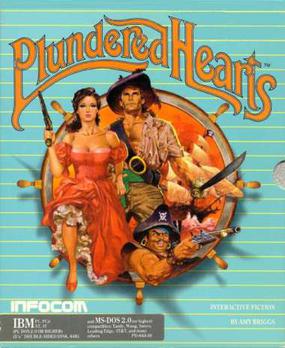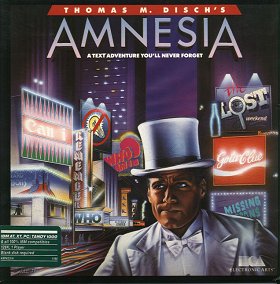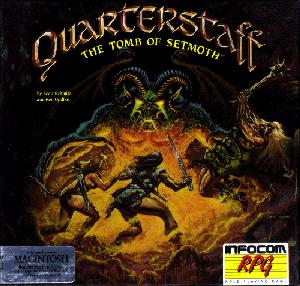Infocom was an American software company based in Cambridge, Massachusetts, that produced numerous works of interactive fiction. They also produced a business application, a relational database called Cornerstone.

Suspended: A Cryogenic Nightmare is an interactive fiction video game written by Michael Berlyn and published by Infocom in 1983. Infocom's sixth game, it was released for Amstrad CPC, Apple II, Atari 8-bit computers, Commodore 64, Commodore Plus/4, IBM PC compatibles, TRS-80, and TI-99/4A. It was later available for Mac, Amiga, and Atari ST.

The Hitchhiker's Guide to the Galaxy is an interactive fiction video game based on the comedic science fiction series of the same name. It was designed by series creator Douglas Adams and Infocom's Steve Meretzky, and it was first released in 1984 for the Apple II, Mac, Commodore 64, CP/M, MS-DOS, Amiga, Atari 8-bit computers, and Atari ST. It is Infocom's fourteenth game.

Bureaucracy is an interactive fiction video game released by Infocom in 1987, scripted by comic science fiction author Douglas Adams. Infocom's twenty-fourth game, it is part of the Infocom Plus range which requires a machine with a minimum of 128K of memory.

Wishbringer: The Magick Stone of Dreams is an interactive fiction video game written by Brian Moriarty and published by Infocom in 1985. It was intended to be an easier game to solve than the typical Infocom release and provide a good introduction to interactive fiction for inexperienced players, and was well received.

Planetfall is a science fiction themed interactive fiction video game written by Steve Meretzky, and published in 1983 as the eighth game from Infocom. The original release was for Apple II, Atari 8-bit computers, TRS-80, and IBM PC compatibles. Atari ST and Commodore 64 versions were released in 1985. A version for CP/M was also released. Planetfall was Meretzky's first published game, and it proved one of his most popular works and a best-seller for Infocom. It was one of five top-selling games to be re-released in Solid Gold versions with in-game hints. Planetfall uses the Z-machine originally developed for Zork and was added as a bonus to the Zork Anthology.

The Lost Treasures of Infocom is a 1991 compilation of 20 previously-released interactive fiction games developed by Infocom. It was published by Activision for MS-DOS, Macintosh, Amiga, and Apple IIGS versions. It was later re-released on CD-ROM, and in 2012 on iOS.

Enchanter is an interactive fiction game written by Marc Blank and Dave Lebling and published by Infocom in 1983. The first fantasy game published by Infocom after the Zork trilogy, it was originally intended to be Zork IV. The game has a parser that understands over 700 words, making it the most advanced interactive fiction game of its time. It was Infocom's ninth game.

Beyond Zork: The Coconut of Quendoris an interactive fiction video game written by Brian Moriarty and released by Infocom in 1987. It was one of the last games in the Zork series developed by Infocom. It signified a notable departure from the standard format of Infocom's earlier games which relied purely on text and puzzle-solving: among other features, Beyond Zork incorporated a crude on-screen map, the use of character statistics and levels, and RPG combat elements.

The Lurking Horror is an interactive fiction game released by Infocom in 1987. The game was written by Dave Lebling and inspired by the horror fiction writings of H. P. Lovecraft. The original release was for MS-DOS, Apple II, Atari ST, Atari 8-bit computers, and Commodore 64. It was Infocom's 26th game and the only in the horror genre. Infocom rated it as "Standard" in terms of difficulty. Later, it was ported to the Amiga with the addition of sound effects, making it the first Infocom adventure with that feature.

Arthur: The Quest for Excalibur is an illustrated interactive fiction video game written by Bob Bates and published by Infocom in 1989. It was released for the Apple II, Amiga, Mac, and IBM PC compatibles. Atypically for an Infocom product, it shows illustrations of locations, characters and objects within the game. It is Infocom's thirty-fourth game and is the second of two Infocom games developed by Challenge using Infocom's development tools.

Spellbreaker is an interactive fiction video game written by Dave Lebling and published by Infocom in 1985, the third and final game in the "Enchanter Trilogy." It was released for the Amiga, Amstrad CPC, Apple II, Atari 8-bit computers, Atari ST, Commodore 64, Classic Mac OS, and MS-DOS. Infocom's nineteenth game, Spellbreaker is rated "Expert" difficulty.

Deadline is an interactive fiction detective video game published by Infocom in 1982. Written by Marc Blank, it was Infocom's third game. It was released for the Amstrad CPC, Apple II, Atari 8-bit computers, Commodore 64, IBM PC, Osborne 1, TRS-80, and later for the Amiga and Atari ST.

The Witness is an interactive fiction video game published by Infocom in 1983. Like Infocom's earlier title Deadline, it is a murder mystery. The Witness was written in the ZIL language for the Z-machine, which allowed it to be released simultaneously on many systems. It is Infocom's seventh game.

Seastalker is an interactive fiction game written by Stu Galley and Jim Lawrence and published by Infocom in 1984. It was released simultaneously for several popular computer platforms of the time, such as the Commodore 64, Apple II, and IBM PC compatibles. The game was marketed as an introduction to interactive fiction for preteen players, having difficulty rating of "Junior." It was the only game to ever use this rating, which was replaced by the "Introductory" label given to games such as Wishbringer. It is Infocom's twelfth game.

Moonmist is an interactive fiction game written by Stu Galley and Jim Lawrence and published by Infocom in 1986. The game was released simultaneously for the Amiga, Amstrad CPC, Apple II, Atari 8-bit computers, Atari ST, Commodore 64, MS-DOS, TRS-80, TI-99/4A, and Mac. It is Infocom's twenty-second game. Moonmist was re-released in Infocom's 1995 compilation The Mystery Collection, as well as the 1996 compilation Classic Text Adventure Masterpieces.

Plundered Hearts is an interactive fiction video game created by Amy Briggs and published by Infocom in 1987. Infocom's only game in the romance genre, it was released simultaneously for the Commodore 64, Atari 8-bit computers, Atari ST, Amiga, classic Mac OS, and MS-DOS. It is Infocom's twenty-eighth game.

Journey: The Quest Begins is an interactive fiction computer game designed by Marc Blank, with illustrations by Donald Langosy, and released by Infocom in 1989. Like the majority of Infocom's works, it was released simultaneously for several popular computer platforms, such as the Commodore 64, Apple II, and PC. Journey is unusual among Infocom games in that it could be played entirely via mouse or joystick, with no typing required. It was the thirty-fifth and last game released by Infocom before parent company Activision closed the Cambridge office, effectively reducing Infocom to a "label" to be applied to later games.

Amnesia is a text adventure written by science fiction author Thomas M. Disch and programmed by Kevin Bentley. It was published by Electronic Arts in 1986 for IBM PC compatibles and Apple II. A Commodore 64 version was released in 1987. Disch's ironic, rich writing style is in distinct contrast to the functional or tongue-in-cheek tone of most text adventures. Over half of Disch's novel-length manuscript had to be cut from the published version to fit on a 5¼" floppy disk.

Quarterstaff: The Tomb of Setmoth is an interactive fiction role-playing video game developed by Scott Schmitz and Ken Updike and released by Infocom for Macintosh in 1988. The game features a text parser, graphics, a dynamically updated map, and a graphical interface that incorporates Mac OS hierarchical menus.



















